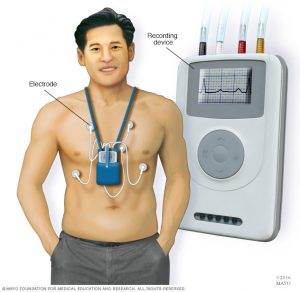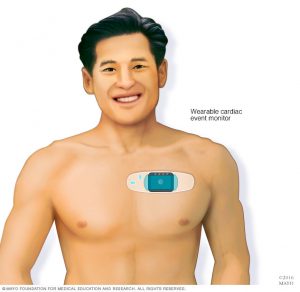
Event Monitor
An event monitor is similar to a Holter monitor, but it is worn for 30 days and is removed only for bathing. It has only two electrodes which are attached to your chest and you will be given a month’s supply of these. Unlike the Holter monitor which records information continually, the event monitor only records your heart’s electrical impulses when you activate it. When you feel symptoms of an event such as shortness of breath, heart racing or skipping, weakness or dizziness, you will activate the device to record by pushing a button.
An event monitor is only able to record a limited amount of information, so you will need to send the data to your doctor’s office for the doctor to review. You will be given more complete instructions on when and how to complete this.
Special instructions for event monitors
Wear the event monitor all the time, other than when you are showering.
If you feel a symptom, activate the event monitor by pressing the button.
Be sure to write down in your diary when you felt a symptom and write specific details including the time and the day and a description of your symptoms.
As much as you can, try to sleep on your back
Follow your normal routine. Don’t try to avoid stress, work, or exercise that occurs in your normal day.
While you are wearing the event monitor, stay away from electric blankets, magnets, and metal detectors and avoid high-voltage areas (such as power lines). Any of these could affect the recording of the monitor.
Follow-Up
Make a follow-up appointment as you have been directed by our staff.
When will I get the results of my study?
Usually test results will be reviewed with you during your follow-up visit with your doctor or over the phone. In some cases, your physician may contact you if any significant findings are found.
If you are confused or concerned about the results, don’t hesitate to Call (919) 363-6060 our office. Our staff will be happy to help answer your questions.
Holter Monitor
A Holter monitor is about the size of a digital camera. When you pick up your monitor from your physician’s office, the technician or nurse will place small pads called electrodes on your chest. These will attach to the monitor and will allow your heart’s electrical impulses to be measured and recorded. The monitor fits inside a small pouch which can be attached to your belt or to a shoulder strap. You will wear the Holter monitor for at least 24 hours.
While you are wearing the Holter monitor you will keep a diary of your activities and also write down if and when you experience any symptoms. You should continue all of your usual daily activities while wearing the monitor, other than you will not be able to take a shower or a bath.
There are a few special instructions to remember about Holter monitors:
As much as you can, try to sleep on your back.
Don’t take a bath or shower. You can take a sponge bath, but do not get the equipment wet. Avoid swimming and other activities that might cause the monitor to get wet.
Follow your normal routine. Don’t try to avoid stress, work, or exercise that occurs in your normal day.
While you are wearing the Holter monitor, stay away from electric blankets, magnets, and metal detectors and avoid high-voltage areas (such as power lines). Any of these could affect the recording of the monitor.
Tips for keeping a diary
Keep a diary of your daily activities. This is very important because it might help match your symptoms to times when your heart rhythm is abnormal.
Be sure to write down when you take medications, when you are driving, when you go to bed or take a nap, when you get up in the morning, when you are under stress or feel anxious.
For each entry you make in your diary, be sure to record the time of day.
Be sure to write down any symptoms you experience.
Activate the monitor as instructed when you feel any unusual symptoms.
Follow-Up
Make a follow-up appointment as you have been directed by our staff. Call (919) 363-6060

